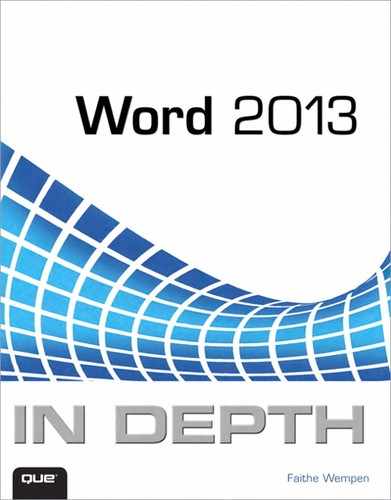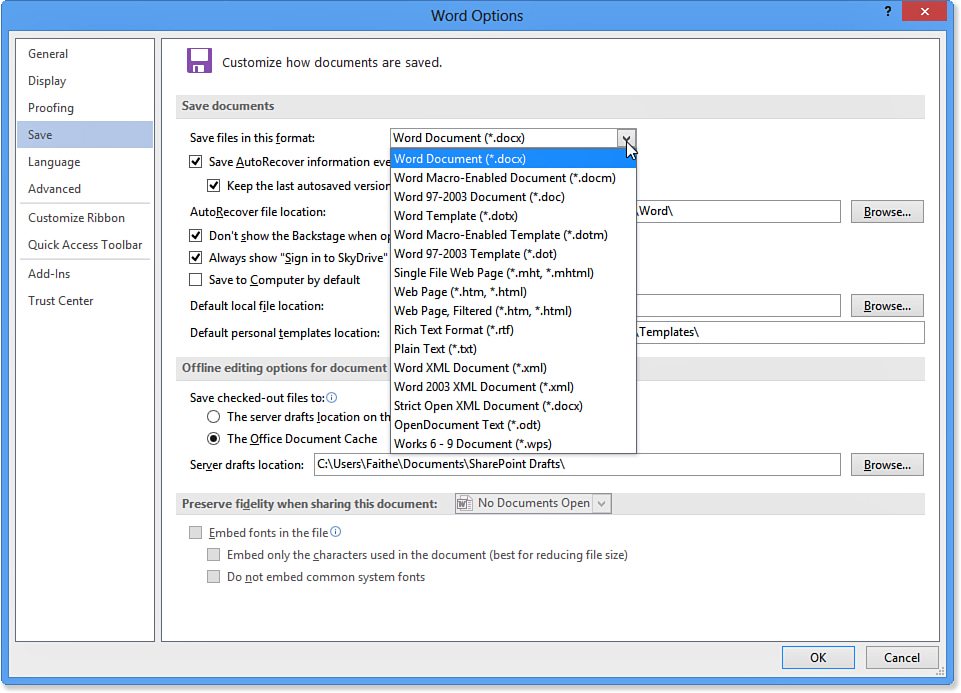B. Converting from Other Word Processing Systems
Converting from Previous Word Versions
If you are upgrading to Word 2013 from an earlier version of Microsoft Word—even really old versions—you’ll be pleasantly surprised at the ease with which your new program handles your old files. In most cases, they open seamlessly and automatically, with no warnings or decisions for you to make.
Ever since the earliest versions, Microsoft Word has standardized on the .doc extension for its files. Although Word 2007 and later changed this to .docx for its native-format files or .docm for macro-enabled documents, all versions of Word can still open .doc files, too.
To make sure .doc files are displayed in the Open dialog box, choose All Word Documents in the Files of Type list (see Figure B.1). If this setting is set to Word Documents (.docx), only the Word 2007 and later format files appear.
Figure B.1. Make sure the Files of Type setting is All Word Documents to catch all the files from previous Word versions.
Converting from Microsoft Works
Microsoft Works was an all-in-one suite of applications designed for casual or home use; it’s like a scaled-down version of Office. New versions of it are no longer being released; the latest version, Version 9, has been out for quite a few years now.
There have actually been two different Microsoft Works products sold: the regular Works, which had its own proprietary word processor; and Works Suite, which has Microsoft Word as its word processor. If you used Works Suite, you’re good to go with the instructions from the preceding section.
There have been many versions of Microsoft Works over the years, starting with an MS-DOS version; there have also been several Mac versions. They all use the same file extension: .wps. The actual file formats, however, have changed dramatically over the years. Word 2013 supports only the files from the post-2001 versions (6.0 and later).
If your Works word processor file is version 6.0 or later, you can open it from the Open dialog box by choosing Works 6 - 9 Document (*.wps) as the Files of Type setting.
If your Works version is earlier than 6.0, you need to perform an interim save step. In your version of Works, use the Save As command to save the file in Rich Text Format (.rtf); then open the resulting file in Word 2013.
Converting from WordPerfect
Earlier versions of Word included extensive tools and help for people upgrading to Word from WordPerfect. This was deemed necessary because WordPerfect was the most popular word processor in the world for more than a decade.
However, nowadays WordPerfect is not nearly the powerhouse it once was, and people converting to Word from older versions of WordPerfect are now few and far between. Therefore, in Word 2013, Microsoft has drastically scaled back the WordPerfect transitional features. Gone are the special WordPerfect shortcut key conversion helpers from the Help system, for example.
Word 2013 opens WordPerfect files in either 5.x or 6.x format. WordPerfect 5.x files use the .doc extension (which can be confusing because that was Word’s default extension); WordPerfect 6.x files use either the .doc or .wpd extension.
To open WordPerfect files, set Files of Type to the appropriate file type. If you are not sure which WordPerfect version file you have, choose WordPerfect 6.x because that includes both of the possible file extensions.
Converting from an Unsupported File Format
Occasionally, you may encounter a file created in some really old, odd word processing system. Perhaps the original program that created it isn’t available anymore, so there’s no way of saving it in a more compatible format.
You might not be able to preserve all the formatting from such a file, but you can at least extract the text from it. To do so, in the Open dialog box set Files of Type to Recover Text from Any File (*.*). This enables Word to see every file type. Then select the file and click Open, and Word does its best to extract as much text as possible.
Confirming File Conversions
Word 2013 converts files silently as it opens them whenever possible. If you want to be notified when this happens, turn on the Confirm File Format Conversion on Open feature by following these steps:
1. Choose File, Options. The Word Options dialog box opens.
2. Click Advanced.
3. Scroll down to the General section and mark the Confirm File Format Conversion on Open check box.
4. Click OK.
Sharing Word Documents with Other Programs
The default file format in Word 2013 is .docx, a proprietary XML-based format that is compatible only with Word 2007 and 2010. (The macro-enabled version, .docm, isn’t compatible with anything but Word 2007 and later either.)
If you need to share a document with someone who uses some other program, you need to use the Save As feature to save it in another file format. For Word versions from Word 97 to Word 2003, the Word 97-2003 Document format is your best bet; for earlier versions than that, use Rich Text Format (*.rtf).
![]() To learn about saving in other different formats, see “Saving a Document,” p. 24.
To learn about saving in other different formats, see “Saving a Document,” p. 24.
Word 2013 does not save in WordPerfect or other word processing formats (except Microsoft Works), but most of those programs will accept RTF files and Word 97-2003 files; so in most cases, it is best to try opening the file in the other word processing program. If it won’t open, you can at least see what formats the program does accept and then try to find one that Word can save as.
For users of Word 2003 and earlier, Microsoft has made a Compatibility Pack available for free download that enables those versions to open Word 2007 and later files. You can download it from http://office.microsoft.com. You can’t assume that everyone who has an earlier version of Word will do this, however, so it’s usually best to save files in Word 97-2003 format if you think others who don’t have Word 2007 or later might want to read them.
Setting a Default Save Format
If not everyone in your group has upgraded to Word 2007 or later, you will not be able to share Word documents in the default Word 2013 format with some people.
If you frequently share documents with others who use earlier versions, and you don’t want to worry about whether they have the needed converter, your best bet is to set up Word to save by default in the Word 97-2003 format. The default format you specify affects only new files; when you resave an existing file, it is saved in its existing format.
To specify a different file format as your default save format, follow these steps:
1. Choose File, Options. The Word Options dialog box opens.
2. Click Save.
3. Open the Save Files in This Format list and select the desired file format (see Figure B.2).
Figure B.2. Choose a different format as your default save format.
4. Click OK.
Displaying Word Files on Computers Without Any Version of Word
Microsoft Word isn’t free, of course, and not all computers have it installed. If you encounter a system that doesn’t have Word but needs to open Word documents, here are some options:
• Users can open Word 97-2003 documents in WordPad, the free word processing application that comes with Microsoft Windows. Some of the features of the Word document will not be visible, and you cannot save in Word format from WordPad. (However, you can save in RTF, which all versions of Word can open.)
• You can use Word 2013 to save in HTML format, which anyone using a web browser can read.
![]() Caution
Caution
The Windows XP and Windows Vista versions of WordPad cannot open Word 2013 files, so you need to save the files in an earlier format to share with these users. The Windows 7 and 8 versions of WordPad can open a Word 2013 document, but not all features are supported.
• You can use Word 2013 to save in PDF format, which anyone with Adobe Reader can read. (Adobe Reader is free from http://www.adobe.com.)
• You can use Word 2013 to save in XPS format, which anyone with Windows Vista, 7, or 8 can read through Windows’ XPS reader utility.
• You can save in a plain text format, which can then be opened in any text application on any type of computer, including mainframes, Linux, UNIX, Macintosh, and so on. Some of those systems might not accept disks formatted in the Windows/DOS file system, but you can transfer files to such systems as email attachments or via a network gateway.
• You can provide the Microsoft Word Viewer, a free application that can be copied and distributed. This small program, available for download from http://office.microsoft.com (search for “Word viewer”), enables any Windows user to view and print any Word 97-2003 document. It supports many, although not all, Word 2007 and later features. For example, it supports Print Layout view, Outline view, Web Layout view, Document Map, zooming, headers, footers, footnotes, comments, and hyperlinks. The downside is that you can’t edit text in Word Viewer. However, you can copy the text into another application through the Windows Clipboard and then paste that text into some other text-editing program. Although Word Viewer can coexist with Word on the same computer, it works best on computers on which Word isn’t installed. Even though the Word Viewer Setup program is designed to ask whether Word or Word Viewer should be the default for opening Word files, you may sometimes find that the wrong application loads if they are both installed.
• You can use the Office Web Apps online. These are web-based versions of Office applications, and you can get started with them for free. Go to http://office.microsoft.com/en-us/web-apps. After you sign up (if needed), it directs you to a SkyDrive, and from there you can create and view several types of Office content.


